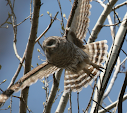
Lots of recent birding, with limited photographic success recently. It all started yesterday morning when I left early to swing by Greenlee Preserve for an hour of birding on the way to work. I had lots of birds there, but the majority were flocking Robins. They were gathering into large groups and incredibly active in the trees as the sun rose. No unusual species, and nothing eye-popping in the way of photographs. Yesterday afternoon I was planning on a trip to Boulder Reservoir to see if I could locate some Sabine's Gulls that had been reported several times. As I was ready to leave work I checked my email and saw that a well known Boulder birder had reported a Sprague's Pipit in Boulder County, and was going to lead a group in hopes of relocating it at 4:00. The time then was 3:55, I sent a hasty reply that I was on my way, and was off. I put several new faces with names I had known only from email, and our group of eight was off to the top of the mesa. Fortunately the bird had not strayed far from the location where it had first been seen, and we spent the next hour moving back and forth with the bird. I had gotten good looks through my bins, but no photographs. Others in the group had more luck, capturing identifiable pictures of the species - a first recorded sighting in Boulder County. Later I checked back with the finder to see if his invitation for another early morning group had room for me to repeat, in an attempt to get some photos of the bird. It did, and so I found myself back at the mesa at 7:00am this morning to try my luck again.
Another chance to meet other birders face to face, some whom I had met once or twice, and many who were first time acquaintances. This time as we climbed the hill we stopped at the call of a longspur - (birding with groups of top birders has its benefits) - which was quickly identified as a Chestnut-collared Longspur. That one did allow a couple of photographs as it worked through the brush, and then popped up to the barbed-wire fence in the morning sunlight. Cha-ching! In the photo below note the extended rear toe that is consistent across all members of this family, and is the basis for the name "Longspur". Soon the two Chestnut-collareds were off, and we did not pursue, as we were hoping that the Sprague's Pipit had remained in the area overnight. It had, and was soon found as it displayed its flight pattern that distinguished it from the other species in the area. It would take off out of dense brush and fly straight up into the air. At maybe 25 ft or so it would level out, and fly horizontally to its next location. Then it would dive straight back down to the ground. The Sprague's Pipit favors short grass prairie, and was amazingly good at moving undetected, even through the minimal vegetation surrounding the prairie dog colonies.
I am still photo-less on the Pipit, but a replacement lifer perched in the early morning light works too.



























